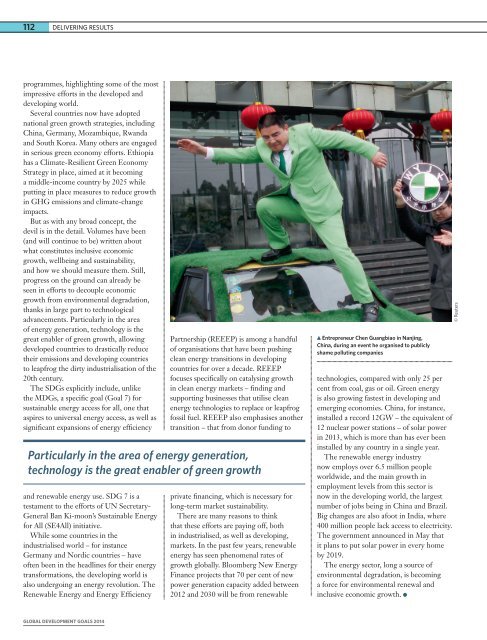FAMBB
FAMBB
FAMBB
You also want an ePaper? Increase the reach of your titles
YUMPU automatically turns print PDFs into web optimized ePapers that Google loves.
112 DELIVERING RESULTSprogrammes, highlighting some of the mostimpressive efforts in the developed anddeveloping world.Several countries now have adoptednational green growth strategies, includingChina, Germany, Mozambique, Rwandaand South Korea. Many others are engagedin serious green economy efforts. Ethiopiahas a Climate-Resilient Green EconomyStrategy in place, aimed at it becominga middle-income country by 2025 whileputting in place measures to reduce growthin GHG emissions and climate-changeimpacts.But as with any broad concept, thedevil is in the detail. Volumes have been(and will continue to be) written aboutwhat constitutes inclusive economicgrowth, wellbeing and sustainability,and how we should measure them. Still,progress on the ground can already beseen in efforts to decouple economicgrowth from environmental degradation,thanks in large part to technologicaladvancements. Particularly in the areaof energy generation, technology is thegreat enabler of green growth, allowingdeveloped countries to drastically reducetheir emissions and developing countriesto leapfrog the dirty industrialisation of the20th century.The SDGs explicitly include, unlikethe MDGs, a specific goal (Goal 7) forsustainable energy access for all, one thataspires to universal energy access, as well assignificant expansions of energy efficiencyPartnership (REEEP) is among a handfulof organisations that have been pushingclean energy transitions in developingcountries for over a decade. REEEPfocuses specifically on catalysing growthin clean energy markets – finding andsupporting businesses that utilise cleanenergy technologies to replace or leapfrogfossil fuel. REEEP also emphasises anothertransition – that from donor funding toParticularly in the area of energy generation,technology is the great enabler of green growthand renewable energy use. SDG 7 is atestament to the efforts of UN Secretary-General Ban Ki-moon’s Sustainable Energyfor All (SE4All) initiative.While some countries in theindustrialised world – for instanceGermany and Nordic countries – haveoften been in the headlines for their energytransformations, the developing world isalso undergoing an energy revolution. TheRenewable Energy and Energy Efficiencyprivate financing, which is necessary forlong-term market sustainability.There are many reasons to thinkthat these efforts are paying off, bothin industrialised, as well as developing,markets. In the past few years, renewableenergy has seen phenomenal rates ofgrowth globally. Bloomberg New EnergyFinance projects that 70 per cent of newpower generation capacity added between2012 and 2030 will be from renewableEntrepreneur Chen Guangbiao in Nanjing,China, during an event he organised to publiclyshame polluting companiestechnologies, compared with only 25 percent from coal, gas or oil. Green energyis also growing fastest in developing andemerging economies. China, for instance,installed a record 12GW – the equivalent of12 nuclear power stations – of solar powerin 2013, which is more than has ever beeninstalled by any country in a single year.The renewable energy industrynow employs over 6.5 million peopleworldwide, and the main growth inemployment levels from this sector isnow in the developing world, the largestnumber of jobs being in China and Brazil.Big changes are also afoot in India, where400 million people lack access to electricity.The government announced in May thatit plans to put solar power in every homeby 2019.The energy sector, long a source ofenvironmental degradation, is becominga force for environmental renewal andinclusive economic growth.© ReutersGLOBAL DEVELOPMENT GOALS 2014


